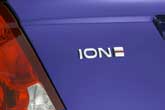Recent Articles
Popular Makes
Body Types
2004 Saturn Ion Red Line
Not your family-friendly Saturn
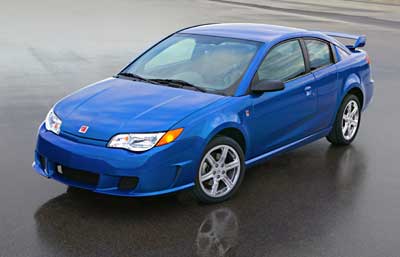
General Motor's Performance Division has been responsible for several of the latest automobile enthusiast's entrees. Included are the Chevrolet Silverado SS and the Pontiac Grand Prix GXP. Both of these vehicles are sport-tuned, high power versions of already-existing base models. GM titles them "High-Performance Variants." Now, souped-up Chevys and Pontiacs are nothing new. However, for 2004, a new player cycles through the Performance Division wash. Saturn's ION can now be stained "Red Line," as enthusiast-oriented modifications evoke spirited driving at the limits.Red Line is part of an effort at Saturn to revamp the image of this carmaker known for being "different" and "family friendly". That is, the Saturn brand does not just represent economical, no-haggle vehicles with "hip" modern styling. ION Red Line specifically targets the 'tuner" market, or those customers seeking compact, FWD, 4-cylinder cars that are easily modifiable. Think Honda Civic with neon paint, ground effects, and front and rear spoilers. Tuner cars like the Civic originated in Southern California, but have grown popular nationwide. Saturn hopes to expand its customer base by appealing to the twenty-somethings who typically invest in these cars. Saturn will even offer a Red Line version of the VUE SUV. Glance quickly at the ION Red Line, and you know it exceeds basic transportation status. Rocker moldings along the sides accentuate the connection with the pavement, while unique front and rear fascias wrap the ends. Up front, a large air dam is located in the standard position below the grille and headlights.
Page 2: Engine
However, auxiliary vents positioned directly ahead of the front wheels collect air from the front, and provide even more flow. A special fascia covers the tail end, but the real attraction back there is the large wing mounted to the trunklid. Several different versions are available.Modifications inside include heavily-bolstered Recaro racing-style seats, special foot pedals, and a short throw shifter. All IONs now get improved materials and fabrics inside, including "soft touch" paint on the center stack. That stack includes Saturn's traditional center-mounted instrument cluster, a feature that receives high customer approval, according to the company. Aesthetic improvements, both inside and out, are well appreciated by the tuner crowd. However, the real magic has to occur behind the sheetmetal. Fortunately for Saturn, the considerable effort invested into making the guts of the ION Red Line race worthy show. Start with the engine. The 2.2-liter Ecotec inline-4 that propels base IONs has undergone extensive reworking. Most notably, an Eaton supercharger with a water-to-air intercooler was added to the engine's intake system. This required a stronger crank and connecting rods, as well as a slight drop in compression ratio (9.5:1 vs. 10.0:1). Larger valves, a heavier alternator, and an all-new drive-by-wire throttle system have also been added. A high-flow, performance tuned exhaust system releases waste gases. Displacement has decreased slightly to 2 liters, but with the addition of a blower Saturn says the Red Line is good for 200 hp. and 200 lb.-ft. of torque. Compared to the 140 hp. and 145 lb.-ft. in the naturally aspirated 2.2, this output is largely significant in a vehicle this small. Power is routed through a 5-speed Getrag manual transmission - Red Lines will not see the 5-speed automatics or continuously variable automatic versions used in other ION variations.
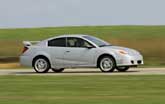
Page 3: Perform
Tuner enthusiasts love power, and Saturn has answered the call, however, vehicle dynamics are also hugely important if the car is to function as more than a show-off piece. Drivers want cars they can drive hard. Again, Saturn accommodates this desire. First, five-spoke, 17-in. alloy wheels with 215/45-series performance Continental tires provide larger contact patches. Disc brakes up front are 1.5-in. larger in rotor diameter than the standard ION's. In the back, discs replace the standard drums, and the entire system is supplemented electronically by standard ABS.Stiffer springs, heavier stabilizer bars, and harder shocks all contribute to a flatter, crisper ride. Saturn calls the revised suspension "racetrack-bred." Additionally, ride height has been lowered slightly by 10 mm. Quicker steering is achieved by a reduced lock-to-lock wheel effort - the power rack-and-pinion system requires only 2.9 turns instead of the normal 3.5. Dual-stage front airbags, four-wheel discs, and ABS are the standard safety features. Curtain airbags that protect the head and neck are available, and they cover both the front and rear outboard passengers. ION Red Lines are not offered with traction control. Saturn Ion Red Lines should appeal to the tuner market in the same way that Dodge SRT-4s, Honda Civic Sis, and Ford SVT Focuses do - as value-priced cars that are "street-worthy" right from the factory. Sure, you can put 20-grand into a Chevy Cavalier, but Saturn offers a hot-rod that's ready to fly right out of the package. For now, the ION Red Line is still a novelty - pilot one and you'll stand out from the crowd. For Saturn, however, the best scenario is one in which driving a Red Line makes you fit in with the masses.
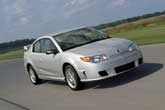
Page 4: FAQs
What is the Saturn Ion Red Line? Saturn has been known as the "Family Friendly" and "Different" car division of General Motors. Now, interested in some image changing and attracting new buyers, this new model is designed as a performance enthusiast's car and is GM's and Saturn's first entry into the sport compact market. Although the new model is track-capable, it gives a road-friendly ride for everyday driving, and has been designed with room left for buyers to perform vehicle personalization.When does the new Saturn Red Line go on sale, and how many does Saturn hope to sell? Production started in April and models should be in dealerships soon. Saturn hopes to sell 5,000 units annually. What are the Ion Red Line's performance stats? The zippy new model's stop and go data includes: zero-to-60 time of 6.3 seconds; ¼ mile in 14.8 seconds; top speed of 144 mph; zero-to-60 stopping distance of 119 ft.; and a maximum latitude of 0.85 g. How does it handle and what makes it go and go smoothly? Built on GM's Delta architecture, with parts pulled out of the GM toolbox and an Ecotec engine that has been supercharged and inter-cooled, the new Red Line is a capable new player in the sports compact car segment. We drove it on roadways surrounding GM's Proving Grounds, in Milford, MI, and found it easy and fun-to-drive, with just enough performance feedback to tickle our senses and give great on-road handling. Where we really enjoyed it, however, was at a new test track on the grounds of GM's testing facility. While displacement has decreased slightly to 2 liters, the addition of a blower makes the Red Line good for 200 hp. and 200 lb.-ft. of torque. (Compared to the 140 hp. and 145 lb.-ft. in the naturally aspirated 2.2, this output is largely significant in a vehicle this small package). Ready-on-tap power is routed through a short-throw 5-speed Getrag manual transmission and gets routed to 215/45-series performance Continental tires with large contact patches. Disc brakes up front are 1.5-in. larger in rotor diameter than the standard ION's and, in the back, discs replace the standard drums, and the entire system is supplemented electronically by standard ABS. Stiffer springs, heavier stabilizer bars, and harder shocks all contribute to a flatter, crisper ride. Saturn calls the revised suspension "racetrack-bred." Additionally, ride height has been lowered slightly by 10 mm. Quicker steering is achieved by a reduced lock-to-lock wheel effort - the power rack-and-pinion system requires only 2.9 turns instead of the normal 3.5. What's its best feature? The Red Line Ion's is exciting because of its fun factor and its price. Its exterior looks are pleasant, but certainly not head-turning and the same can be said for its interior styling. Where it shines is on the road, when there's no one in sight and the road is good, as well as on the track, where it handles just like a sport compact car should. And, as Saturn hopes, there's a lot of room to go or grow, for those with the right interest. Look for souped-up models at SEMA this fall!
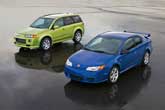
Page 5: Writer's Notes
Base price: $20, 950 (includes $565 transportation) Engine: 2-liter supercharged inline-4 (200 hp, 200 lb.-ft. of torque (estimated) Transmission: 5-speed manual (Getrag) Wheelbase: 103.5 in. Length: 185 in. Width: 67.9 in. Height: 55.8 in. Head/leg/hiproom: front: 38.9/42.2/49.4 in.; rear: 36.5/32.7/48.3 in. Curb weight, lbs.: 2,590 Fuel economy: 24 city/30 highway mpg (estimated) Safety equipment: Dual two-stage frontal airbags; optional head-curtain airbags; 4-wheel disc brakes with standard ABS
